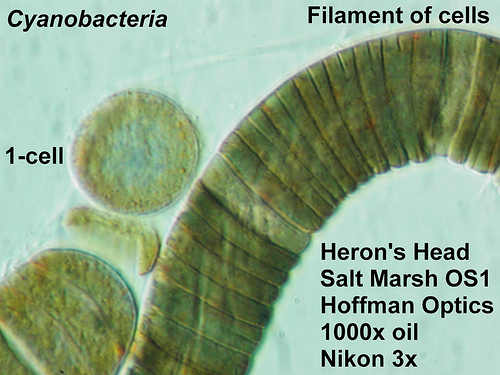
|
Cyanobacteria Doing the Dance of 3.5-billion Years Wayne Lanier, San Francisco USA |
The mat-forming Cyanobacteria of San Francisco Bay salt marsh ponds are slowly motile, presumably moving in response to carbon dioxide concentration, light, and oxygen tension. These ancient filamentous bacteria have been moving in mats like this for the last 3.5-billion years, creating our present oxygen atmosphere during the first 3-billion of those years.
I wanted to capture, in motion and sound, a sense of this deep time - and of the continuous slow restless movement over all those years. The cello seemed to produce the right low sonorous tones; Hoffman Modulation Contrast optics [REF-1], at 1,000x, produced the moving image.
The sample was taken from the bottom mat of a tide-washed pond in Heron's Head Park salt marsh, San Francisco, California [REF-2]. A simple wet mount of a 50-microliter sample was used. Stop cock grease was used around the edge of the cover slip to anchor it firmly and prevent evaporation. The salinity of the sample was 40-PPT.
The lowest point around the sample pond is about 1.85-meters above datum, so the pond is washed by Bay water only when the high tide exceeds 1.85-m above datum. This occurs at irregular intervals, ranging between several weeks and every other high tide [4-week example in REF-3]. The average Bay salinity is about 32-PPT, so each time the pond is tide washed its salinity is reset to the Bay value. When the interval between high tides of 1.85-m is very long, evaporation from wind and sun reduces the pond volume and may drive the salinity up to more than 50-PPT. A stable, dense healthy Cyanobacterial mat forms when the salinity varies between around 30-PPT and 50-PPT.
My microscope uses 20-year old Olympus HMC optics, supported on a modified Olympus Irvine 6X6 trinocular stand, with a Cole Parmer High Intensity 150W Illuminator attached via a 3/4″ lucite rod light conductor [HMC is a real light hog]. The oil immersion 100x objective was used with 10x eyepieces and a 10x Zeiss screw-top eyepiece in the trinocular camera mount. Videomicrographs were shot over a 6-hour period.
First, here is a photomicrograph of the Cyanobacteria. The genus is Oscillatoria and the species is unidentified.

Videomicrographs were taken in 30-second segments at standard video frame speed with a Nikon Coolpix 885 camera screwed to the Zeiss eyepiece with as Nikon UR-E4 ring. The 30-second segments were downloaded to my PC, where they were trimmed and joined in QuickTime Pro.
I created the “Cello” background using the application GarageBand on my Mac iBook G4. Here is a fragment of the score…

A Lexar 2GB memory chip was then used to transfer the final QuickTime video to the Mac iBook. The QuickTime video track and the GarageBand 557-kB sound track were mixed on iMovie. The resulting “movie” was downloaded to YouTube, from whence it was embedded in this report. In the image below, click on the black triangle to play the videomicrograph. You will need the application QuickTime [REF-4] and you will need your system sound turned on.
All comments to the author, Wayne Lanier, are welcomed.
REFERENCES
1: Olympus Microscopy Resource Center Hoffman Modulation Contrast
2: Use Google Earth and zoom in at LONG -122.374233313877 LAT 37.73566549377075
3: University of South Carolina, Biological Sciences Tide and Current Predictor for Hunter's Point.
4: Quicktime
download.
Please report
any Web problems or offer general comments to the
Micscape
Editor,
via the contact
on current Micscape Index.
Micscape is the
on-line monthly magazine of the Microscopy UK
web
site at
Microscopy-UK